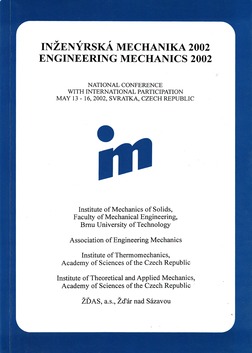Proceedings Vol. 8 (2002)

INŽENÝRSKÁ MECHANIKA 2002
ENGINEERING MECHANICS 2002
May 13 – 16, 2002, Svratka, Czech Republic
Copyright © 2002 Institute of Mechanics of Solids, Faculty of Mechanical Engineering, Bruno University of Technology, Brno
ISSN 1805-8248 (printed)
ISSN 1805-8256 (electronic)
list of papers scientific commitee
pages 27 - +9p., full text
The topic of this paper is a computer simulation of treatment of children spine deformities with braces (orthosis). Orthopaedists in the Czech Republic use corrective braces of type Cheneau or Cerny. The brace has force effects on a child skeleton. First, the negative plaster form of a child trunk is made and then the positive plaster form is created. The orthopaedist determines the loading place and the plaster form is deepened in this place. The laminate brace made according to this plaster form pushes the child trunk (like a tight shoe). The research is supported by a grant of the Czech Grant Agency No. 10610010006 "Functional Adaptation and Pathobiomechanics of Limb and Axial Skeleton under Force Effects ". The paper shows the manner of determination of the stress state in vertebrae and inter-vertebra discs and the solution of the spinal curve correction under brace force effects for a concrete child patient. The project searches the dependence of the activation and velocity of the spinal curve correction in the spinal stress state for many patients. It means that the paper shows the computing algorithms for spinal deformations and the stress state under brace force effects and the simulation of the spinal curve correction. Louis's model of the spine is used. The breast curve classification can be used according to King. Note that the brace of type Chenau is recommended for the spinal curve type King I, I/, and IV and the brace of type Cerny for the spinal curve of type King I/, III a V The spinal deformations are solved by the finite element method as a beam (spine) in an elastic ground (soft tissue) loaded by given displacements or by the finite element method using vertebrae, inter-vertebra discs and soft tissue elements. The Ft method is described in the article. The calculation algorithm and parameters are verified with treatment courses. The sensor plates put into braces have measured the load values between the brace and the child trunk surface. The simulation program assesses the spinal curve correction according to the spinal stress state and the time for which the brace has been used.
back to list of papers
Text and facts may be copied and used freely, but credit should be given to these Proceedings.
All papers were reviewed by members of the scientific committee.

 Powered by
Imce 3.20 © 2023, Pavel Formánek, Institute of Thermomechanics AS CR, v.v.i. [generated: 0.0109s]
Powered by
Imce 3.20 © 2023, Pavel Formánek, Institute of Thermomechanics AS CR, v.v.i. [generated: 0.0109s]